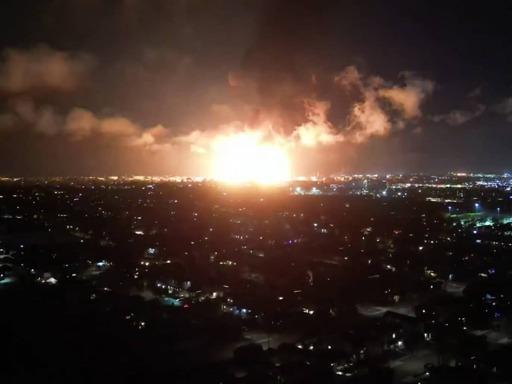If you ever wanted a visual representation of just why fossil fuels are so bad, look no further than California. That’s because a Chevron oil refinery has gone up in smoke – and it quite literally looked like something from a Roland Emmerich blockbuster. Except in this instance, the scenes are far from entertaining.
Chevron: blowing up California (again)
A massive blaze ripped through Chevron’s El Segundo refinery in Los Angeles on Friday 3 October. CCTV caught the moment the explosion happened:
#BREAKING Explosion tonight at the Chevron El Segundo Oil Refinery right outside Los Angeles
Chevron oil company was declared a target by Yemeni Houthis a few days ago pic.twitter.com/8fLzNRqsFI
— Conflict Radar (@Conflict_Radar) October 3, 2025
Local residents filmed what were at time apocalyptic scenes:
This was the view of the El Segundo Chevron refinery blaze from my neighborhood in Manhattan Beach. pic.twitter.com/I475JysGvd
— Norgard (@BrianNorgard) October 3, 2025
From above, the impact was clear:
A fire at Chevron’s El Segundo refinery in Los Angeles has been contained, local police said.
There were no reports of injuries and all personnel were accounted for, Chevron said in a statement, according to the AP.
Read more:
https://t.co/DHRfNUQLNx pic.twitter.com/IEXJhDPdAW
— The Wall Street Journal (@WSJ) October 3, 2025
What was also clear was that the Chevron catastrophe exposed in dramatic fashion just how fragile, dangerous, and irresponsible fossil fuel infrastructure remains – not least when it’s controlled by corporations that care little for public safety or climate accountability.
Though Chevron quickly announced that no injuries occurred and said the fire was contained to one unit, this is hardly recompence. The refinery in question is Chevron’s second-largest in the US, supplying about 20% of the motor fuel and a staggering 40% of the jet fuel used in southern California.
That concentration of energy supply gives Chevron disproportionate power over essential infrastructure — power it wields without doing the necessary groundwork to prevent catastrophe.
Not that Californian residents need telling this.
Decades of institutional failure
It was just over 13 years ago that another explosion at a Chevron plant in the state causes thousands of people to be hospitalised. As the Guardian reported:
Richmond had lived through previous refinery explosions and years of pollution had taken its toll: the prevalence of asthma in the majority Black, Hispanic and Asian town is nearly twice the state average.
Now, this latest explosion adds to Chevron’s rap sheet – which consists of four major incidents since 1989 in California alone.
This latest fire erupted in the “Isomax 7” unit, a facility designed to convert intermediate fuel oils into aviation jet fuel. That unit’s failure signals systemic neglect: Chevron has long claimed to maintain high safety standards, yet here we are — an explosion, conflagration, and the charade of apologies while the public scrambles.
The company’s statement that the cause is “unknown” is a familiar trope — convenient ambiguity that buys them time, not accountability. And when accountability does come, it’s never ‘lessons learned’ for Chevron. ‘
In 2013, the US Chemical Safety Board released their preliminary report into the 2012 accident. It slammed Chevron for a chronic failure to replace aging equipment and called for an overhaul of regulatory oversight of the industry to prevent such accidents from happening again.
How’s that worked out?
Chevron: make them pay
Chevron’s operations have long externalised risk to local communities, ecosystems, and climate stability. Catastrophes like this are hardly exceptions but the inevitable outcome of prioritising profit over resilience. This is not just a technical failure — it is a moral failure.
Yet, the climate criminals always win anyway. As the Los Angeles Times reported:
fires like this typically spike wholesale spot prices, which are reflected at the pumps within a few days. If the refinery is offline for a few weeks, it could substantially raise gasoline prices. Imports and gasoline held in storage could help fill in supplies, but additional imports take up to a month to arrive.
Yes, not only has Chevron caused untold environmental damage – you and me will also pay for it. Not to miss an opportunity to profit, though, Chevron is about to sell-off some more of its less-than-trustworthy infrastructure in the US for the tidy sum of $2 billion.
The health and environmental impact of this latest Chevron fire will not yet be known. However, it once again shows the need for firstly fossil fuel companies to be even ore tightly regulated, but more importantly for them to be wiped off the face of the earth altogether.
Featured image via the Canary
By Steve Topple
From Canary via this RSS feed


